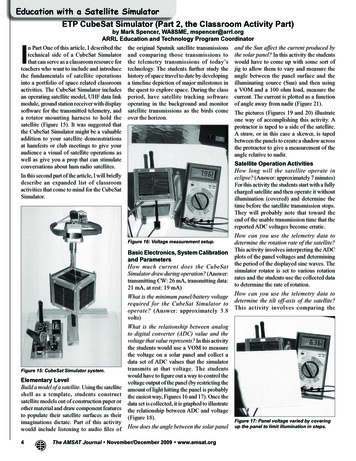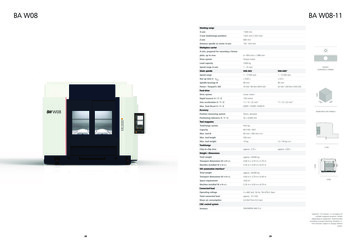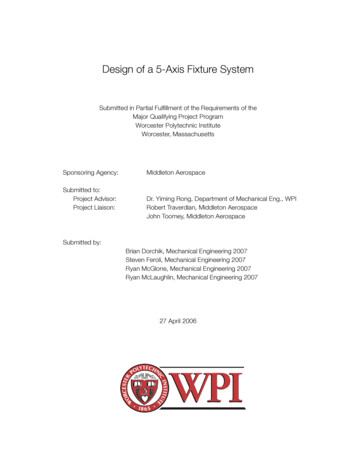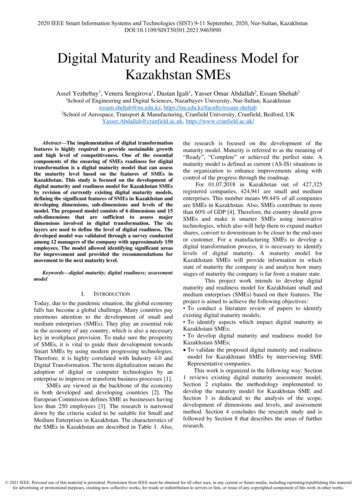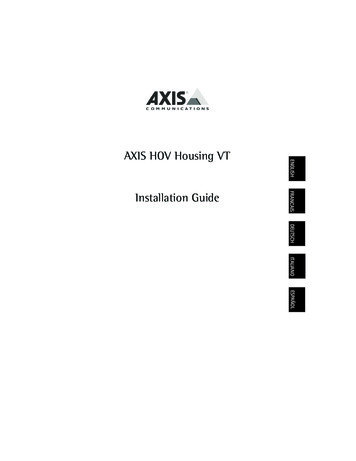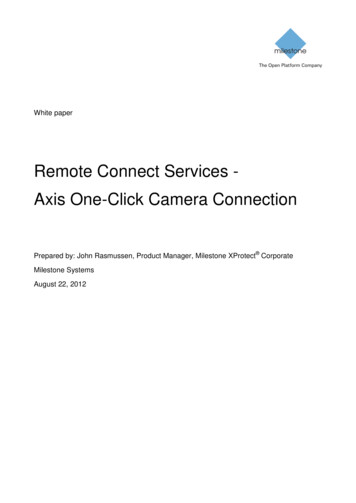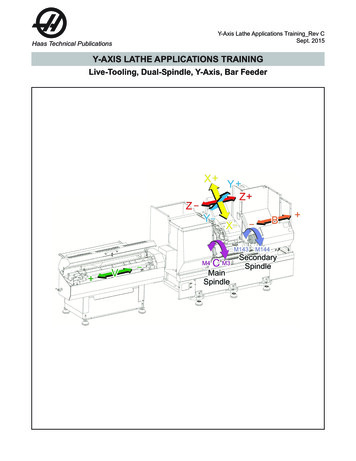
Transcription
Song et al. Journal of Hematology & (2020) 13:24RESEARCHOpen AccessHNF4A-AS1/hnRNPU/CTCF axis as atherapeutic target for aerobic glycolysisand neuroblastoma progressionHuajie Song1†, Dan Li1†, Xiaojing Wang2†, Erhu Fang1, Feng Yang1, Anpei Hu1, Jianqun Wang1, Yanhua Guo1,Yang Liu1, Hongjun Li3, Yajun Chen3, Kai Huang2, Liduan Zheng2,3* and Qiangsong Tong1,2*AbstractBackground: Aerobic glycolysis is a hallmark of metabolic reprogramming that contributes to tumor progression.However, the mechanisms regulating expression of glycolytic genes in neuroblastoma (NB), the most commonextracranial solid tumor in childhood, still remain elusive.Methods: Crucial transcriptional regulators and their downstream glycolytic genes were identified by integrativeanalysis of a publicly available expression profiling dataset. In vitro and in vivo assays were undertaken to explorethe biological effects and underlying mechanisms of transcriptional regulators in NB cells. Survival analysis wasperformed by using Kaplan-Meier method and log-rank test.Results: Hepatocyte nuclear factor 4 alpha (HNF4A) and its derived long noncoding RNA (HNF4A-AS1) promotedaerobic glycolysis and NB progression. Gain- and loss-of-function studies indicated that HNF4A and HNF4A-AS1facilitated the glycolysis process, glucose uptake, lactate production, and ATP levels of NB cells. Mechanistically,transcription factor HNF4A increased the expression of hexokinase 2 (HK2) and solute carrier family 2 member 1(SLC2A1), while HNF4A-AS1 bound to heterogeneous nuclear ribonucleoprotein U (hnRNPU) to facilitate itsinteraction with CCCTC-binding factor (CTCF), resulting in transactivation of CTCF and transcriptional alteration ofHNF4A and other genes associated with tumor progression. Administration of a small peptide blocking HNF4A-AS1hnRNPU interaction or lentivirus-mediated short hairpin RNA targeting HNF4A-AS1 significantly suppressed aerobicglycolysis, tumorigenesis, and aggressiveness of NB cells. In clinical NB cases, high expression of HNF4A-AS1,hnRNPU, CTCF, or HNF4A was associated with poor survival of patients.Conclusions: These findings suggest that therapeutic targeting of HNF4A-AS1/hnRNPU/CTCF axis inhibits aerobicglycolysis and NB progression.Keywords: Hepatocyte nuclear factor 4 alpha antisense RNA 1, Heterogeneous nuclear ribonucleoprotein U,CCCTC-binding factor, Aerobic glycolysis, Tumor progression, Neuroblastoma* Correspondence: ld zheng@hotmail.com; qs tong@hotmail.com†Huajie Song, Dan Li and Xiaojing Wang contributed equally to this work.3Department of Pathology, Union Hospital, Tongji Medical College,Huazhong University of Science and Technology, 1277 Jiefang Avenue,Wuhan 430022, Hubei Province, People’s Republic of China1Department of Pediatric Surgery, Union Hospital, Tongji Medical College,Huazhong University of Science and Technology, 1277 Jiefang Avenue,Wuhan 430022, Hubei Province, People’s Republic of ChinaFull list of author information is available at the end of the articleBackgroundNeuroblastoma (NB) is the most common extracranialsolid tumor in childhood, and accounts for 15% ofpediatric cancer deaths [1]. For high-risk NB, the survival rate of patients still remains low despite multimodal therapy [1]. To maintain tumorigenesis andaggressiveness, tumor cells exert a unique metabolic The Author(s). 2020 Open Access This article is licensed under a Creative Commons Attribution 4.0 International License,which permits use, sharing, adaptation, distribution and reproduction in any medium or format, as long as you giveappropriate credit to the original author(s) and the source, provide a link to the Creative Commons licence, and indicate ifchanges were made. The images or other third party material in this article are included in the article's Creative Commonslicence, unless indicated otherwise in a credit line to the material. If material is not included in the article's Creative Commonslicence and your intended use is not permitted by statutory regulation or exceeds the permitted use, you will need to obtainpermission directly from the copyright holder. To view a copy of this licence, visit http://creativecommons.org/licenses/by/4.0/.The Creative Commons Public Domain Dedication waiver ) applies to thedata made available in this article, unless otherwise stated in a credit line to the data.
Song et al. Journal of Hematology & Oncology(2020) 13:24preference for converting glucose into lactate even inthe presence of sufficient oxygen, a process known as“Warburg effect” or “aerobic glycolysis” [2, 3]. Activationof oncogenes or inactivation of tumor suppressors contributes to glycolytic gene expression in tumor cells. Forexample, c-Myc enhances the alternative splicing ofpyruvate kinase M2 (PKM2) [4], while inactivation ofp53 facilitates the transcription of solute carrier family 2member 3 (SLC2A3) [5]. Inhibition of aerobic glycolysisby small organic molecules, such as 3-bromopyruvate or2-deoxyglucose (2-DG), exhibits therapeutic potentialfor tumors [6, 7]. Thus, it is important to investigate theregulators of aerobic glycolysis for improving therapeuticefficiencies of NB.Long noncoding RNAs (lncRNAs), one type of endogenous RNA longer than 200 nucleotides (nt), play essentialroles in NB progression [8–10]. For example, high expressionof cyclin-dependent kinase inhibitor 2A/alternative readingframe intron 2 lncRNA (CAI2) is associated with poor survival of NB patients [8]. In addition, Ets-1 promoterassociated noncoding RNA promotes NB progressionthrough binding with heterogeneous nuclear ribonucleoprotein K (hnRNPK) and stabilizing β-catenin [9]. Meanwhile,loss of tumor suppressive neuroblastoma-associatedtranscript-1 (NBAT-1) contributes to NB progression by increasing proliferation and reducing differentiation of neuronal precursors [10]. However, the roles of lncRNAs inaerobic glycolysis during NB progression remain elusive.In this study, we identify hepatocyte nuclear factor 4alpha (HNF4A) as a transcription factor facilitating aerobic glycolysis and NB progression, and reveal thatHNF4A antisense RNA 1 (HNF4A-AS1), a lncRNA derived from upstream region of HNF4A, is associated withpoor outcome of NB. HNF4A-AS1 promotes aerobic glycolysis, growth, and aggressiveness of NB cells by bindingto heterogeneous nuclear ribonucleoprotein U (hnRNPU)and facilitating its interaction with CCCTC-binding factor(CTCF), resulting in transactivation of CTCF and transcriptional alteration of HNF4A and other genes associated with tumor progression, indicating the crucial rolesof HNF4A-AS1/hnRNPU/CTCF axis in NB progression.MethodsCell cultureHuman non-transformed mammary epithelial MCF 10A(CRL-10317) cells, embryonic kidney HEK293T (CRL3216) cells, NB cell lines SH-SY5Y (CRL-2266), SK-NAS (CRL-2137), BE(2)-C (CRL-2268), and IMR-32(CCL-127) were purchased from the American TypeCulture Collection (Rockville, MD). Cell lines were authenticated by short tandem repeat profiling, and usedwithin 6 months after resuscitation of frozen aliquots.Mycoplasma contamination was regularly examined withLookout Mycoplasma PCR Detection Kit (Sigma, St.Page 2 of 19Louis, MO). Cells were maintained in Dulbecco’s modified Eagle’s medium (DMEM) supplemented with 10%fetal bovine serum (Gibco, Grand Island, NY), andtreated with insulin or 2-DG (Sigma).RNA isolation, RT-PCR, and real-time quantitative RT-PCR(qRT-PCR)Nuclear, cytoplasmic, and total RNA of tissues and celllines were isolated using RNA Subcellular Isolation Kit(Active Motif, Carlsbad, CA) or RNeasy Mini Kit (Qiagen Inc., Valencia, CA). Total RNA of each serum wasextracted using TRIzol LS reagent (Invitrogen, Carlsbad,CA). Reverse transcription reactions were conductedwith Transcriptor First Strand cDNA Synthesis Kit(Roche, Indianapolis, IN). PCR and real-time PCR wereperformed with Taq PCR Master Mix or SYBR GreenPCR Master Mix (Applied Biosystems, Foster City, CA)and primers (Additional file 1: Table S1). For real-timeqRT-PCR assay, the transcript levels were analyzed by2 ΔΔCt method.Western blotTissue or cellular protein was extracted with 1 celllysis buffer (Promega, Madison, WI). Western blot wasperformed as previously described [9, 11–15], with antibodies for HNF4A (ab181604), hexokinase 2 (HK2,ab104836), solute carrier family 2 member 1 (SLC2A1,ab40084), v-myc avian myelocytomatosis viral oncogeneneuroblastoma-derived homolog (MYCN, ab16898),hnRNPU (ab10297), CTCF (ab188408), clusterin (CLU,ab69644), C-X-C motif chemokine receptor 4 (CXCR4,ab124824), trophoblast glycoprotein (TPBG, ab129058),uveal autoantigen with coiled-coil domains and ankyrinrepeats (UACA, ab99323), FLAG (ab125243), Myc(ab9106), glutathione S-transferase (GST, ab19256), histone H3 (ab5103), or β-actin (ab6276, Abcam Inc., Cambridge, MA).Luciferase reporter assayHuman HNF4A-AS1 (-1418/ 45) or HNF4A (-606/ 128)promoter was amplified from genomic DNA by PCR(Additional file 1: Table S2) and subcloned into pGL3Basic (Promega). Mutation of MYCN or CTCF bindingsite was performed with GeneTailorTM Site-DirectedMutagenesis System (Invitrogen) and primers (Additional file 1: Table S2). Luciferase reporters for transcription factors were established by insertingoligonucleotides containing four canonical binding sites(Additional file 1: Table S2) into pGL3-Basic (Promega).Human p53 luciferase reporter was obtained fromStratagene (La Jolla, CA). Dual-luciferase assay was performed as previously described [9, 11–13], using aluminometer (Lumat LB9507, Berthold Tech., Bad Wildbad, Germany).
Song et al. Journal of Hematology & Oncology(2020) 13:24Chromatin immunoprecipitationChromatin immunoprecipitation (ChIP) assay was performed according to instructions of EZ-ChIP kit (Upstate Biotechnology, Temacula, CA) [9, 11, 14], usingantibodies specific for HNF4A (ab181604), MYCN(ab16898), CTCF (ab188408), RNA polymerase II (RNAPol II, ab5131), histone H3 lysine 4 trimethylation(H3K4me3, ab8580), and histone H3 lysine 27 trimethylation (H3K27me3, ab6002). Real-time quantitative PCR(qPCR) was performed with SYBR Green PCR MasterMix (Applied Biosystems) and primers (Additional file 1:Table S1). Immunoprecipitated DNA was normalized toinput DNA, using isotype IgG as a negative control.Gene over-expression and knockdownHuman HNF4A and MYCN expression vectors wereprovided by Dr. David Martinez Selva [16] and Dr.Arturo Sala [17], respectively. Human HNF4A-AS1cDNA (648 bp), hnRNPU cDNA (2478 bp), CTCF cDNA(2184 bp), and their truncations were amplified from NBtissues (Additional file 1: Table S2) and subcloned intopcDNA3.1 (Invitrogen), pCMV-3Tag-1C, pCMV-NMyc, and pGEX-6P-1 (Addgene, Cambridge, MA), respectively. Mutation of short hairpin RNA (shRNA)-targeting site of HNF4A-AS1 or hnRNPU RGG residueswas performed with GeneTailorTM Site-Directed Mutagenesis System (Invitrogen) and primers (Additional file1: Table S2). Oligonucleotides encoding shRNAs specificfor HNF4A, HK2, SLC2A1, MYCN, HNF4A-AS1,hnRNPU, or CTCF (Additional file 1: Table S3) weresubcloned into GV298 (Genechem Co., Ltd, Shanghai,China). Single guide RNAs (sgRNAs) targeting downstream region of HNF4A-AS1 transcription start site(Additional file 1: Table S3) were inserted into dCas9BFP-KRAB (Addgene). Stable cell lines were screened byadministration of neomycin or puromycin (Invitrogen).Rescue of target gene expressionTo rescue gene expression altered by hnRNPU, CTCF,or HNF4A knockdown, tumor cells were transfectedwith HNF4A-AS1 vector. To restore target gene expression induced by over-expression of hnRNPU, CTCF, orHNF4A, shRNA specific for HNF4A-AS1 (Additional file1: Table S3) was transfected into tumor cells with Genesilencer Transfection Reagent (Genlantis, San Diego,CA). Empty vector and sh-Scb were applied as controls(Additional file 1: Table S3).Lentiviral packagingLentiviral vectors were co-transfected with packagingplasmids psPAX2 and pMD2G (Addgene) intoHEK293T cells. Infectious lentivirus was filtered through0.45 μm PVDF filters, and concentrated 100-fold byultracentrifugation (2 h at 120,000g). Infectious lentivirusPage 3 of 19was harvested at 36 and 60 h after transfection and filtered through 0.45 μm PVDF filters. Recombinant lentivirus was concentrated 100-fold by ultracentrifugation(2 h at 120,000g). Lentivirus-containing pellet was dissolved in phosphate buffer saline (PBS) and injected inmice within 48 h.Rapid amplification of cDNA ends assayTotal RNA was isolated from BE(2)-C cells to prepare rapidamplification of cDNA ends (RACE)-ready cDNA usingSMARTer RACE cDNA Amplification Kit (Clontech, PaloAlto, CA), which was further amplified by PCR primers andnested PCR primers (Additional file 1: Table S1).Northern blotThe 254-bp probe was in vitro transcribed using DIGLabeling Kit (MyLab Corporation, Beijing, China) andT7 RNA polymerase, and treated with RNase-free DNaseI. For Northern blot, 20 μg of total RNA was separatedon 3-(N-morpholino)propanesulfonic acid (MOPS)-buffered 2% (w/v) agarose gel containing 1.2% (v/v) formaldehyde under denaturing conditions for 4 h at 80 V, andtransferred to Hybond-N membrane (Pall Corp., PortWashington, NY). Prehybridization was carried out at65 C for 30 min in DIG Easy Hyb solution (Roche, Indianapolis, IN). Hybridization was performed at 65 Cfor 16–18 h. Blots were washed stringently, detected byanti-digoxigenin (DIG) antibody, and recorded on X-rayfilms with chemiluminescence substrate CSPD (Roche).RNA fluorescence in situ hybridizationAntisense or sense RNA probe for HNF4A-AS1 wasin vitro transcribed with Biotin RNA Labeling Mix(Roche) and T7 RNA polymerase. Cells were seeded oncoverslips, fixed in 4% paraformaldehyde for 15 min, andincubated with 40 nmol·L 1 fluorescence in situhybridization (FISH) probe in hybridization buffer (100mg/ml dextran sulfate, 10% formamide in 2 SSC) at80 C for 2 min. Hybridization was performed at 55 Cfor 2 h, with or without RNase A (20 μg) treatment. Cellswere incubated with streptavidin-conjugated fluoresceinisothiocyanate (FITC), with nuclei counterstained with4′,6-diamidino-2-phenylindole (DAPI).Fluorescence immunocytochemical stainingCells were plated on coverslip, incubated with 5% milkfor 1 h, and treated with antibody specific for hnRNPU(ab10297, Abcam Inc., 1:300 dilution) at 4 C overnight.Then, coverslips were treated with Alexa Fluor 594 goatanti-rabbit IgG (1:1000 dilution) and stained with DAPI(300 nmol·L 1). The images were photographed under aNikon A1Si Laser Scanning Confocal Microscope(Nikon Instruments Inc, Japan).
Song et al. Journal of Hematology & Oncology(2020) 13:24RNA sequencingTotal RNA of tumor cells (1 106) was isolated usingTRIzolTM reagent (Life Technologies, Inc., Gaithersburg,MD). Library preparation and transcriptome sequencingon an Illumina HiSeq X Ten platform were carried outat Novogene Bioinformatics Technology Co., Ltd.(Beijing, China) to generate 100-bp paired-end reads.HTSeq v0.6.0 was applied in counting the numbers ofread mapping to each gene, and fragments per kilobaseof transcript per million fragments mapped (FPKM) ofeach gene were calculated. Sequencing results have beendeposited in GEO database (accession code GSE143896).Page 4 of 19mobility shift assay (EMSA) using nuclear extracts or recombinant hnRNPU protein was performed using LightShift Chemiluminescent RNA EMSA Kit (Thermo FisherScientific, Inc.).Co-immunoprecipitation assayCo-immunoprecipitation (Co-IP) was performed as previously described [9, 12, 14], with antibodies specific forhnRNPU (ab10297), CTCF (ab188408), FLAG(ab125243), or Myc (ab9106, Abcam Inc.). Bead-boundproteins were released and analyzed by Western blot.Bimolecular fluorescence complementation assayBiotin-labeled RNA pull-down and mass spectrometryanalysisBiotin-labeled RNA probes for HNF4A-AS1 truncationswere in vitro transcribed as described above. Nuclear extracts were harvested, resuspended in freshly preparedproteolysis buffer, and incubated with biotin-labeledRNA (10 pmol) and streptavidin-agarose beads (Invitrogen) for 1 h. Precipitated components were separatedusing SDS-PAGE, followed by Coomassie blue stainingor Western blot. Differential bands were harvested formass spectrometry analysis (Wuhan Institute of Biotechnology, Wuhan, China) [9].Cross-linking RNA immunoprecipitationTumor cells (1 108) were ultraviolet light cross-linkedat 254 nm (200 J/cm2) in PBS and collected by scraping[9, 13]. RNA immunoprecipitation (RIP) assay was performed with Magna RIPTM RNA-Binding Protein Immunoprecipitation Kit (Millipore, Bedford, MA), usingantibodies for hnRNPU (ab10297) or hnRNPK (ab39975,Abcam Inc.). Co-precipitated RNAs were detected byRT-PCR or real-time quantitative qRT-PCR withprimers (Additional file 1: Table S1). Total RNAs (input)and isotype antibody (IgG) were applied as controls.In vitro binding assayHuman hnRNPU cDNA (2478 bp) and CTCF cDNA(2184 bp) were subcloned into bimolecular fluorescencecomplementation (BiFC) vectors pBiFC-VN173 andpBiFC-VC155 (Addgene) and co-transfected into tumorcells with Lipofectamine 2000 (Invitrogen) for 24 h.Fluorescence emission was observed under a confocalmicroscope, using excitation and emission wavelengthsof 488 and 500 nm, respectively [14].Design and synthesis of inhibitory peptidesInhibitory peptides for blocking interaction betweenHNF4A-AS1 and hnRNPU were designed. The 11 aminoacid long peptide (YGRKKRRQRRR) from Tat proteintransduction domain served as a cell-penetrating peptide. Thus, inhibitory peptides were chemically synthesized by linking with biotin-labeled cell-penetratingpeptide at N-terminus and conjugating with FITC at Cterminus (ChinaPeptides Co. Ltd, Shanghai, China), withpurity larger than 95%.Biotin-labeled peptide pull-down assayCellular proteins were isolated using 1 cell lysis buffer(Promega), and incubated with biotin-labeled peptideand streptavidin-agarose at 4 C. Then, incubation of celllysates with streptavidin-agarose was undertaken at 4 Cfor 2 h. Beads were extensively washed, and RNA pulleddown was measured by RT-PCR or real-time qRT-PCR.A series of hnRNPU truncations were amplified fromNB tissues (Additional file 1: Table S2), subcloned intopGEX-6P-1 (Addgene), and transformed into E. coli toproduce GST-tagged hnRNPU [9, 11]. HNF4A-AS1cRNA was in vitro transcribed with TranscriptAid T7High Yield Transcription Kit (Thermo Fisher Scientific,Inc., Waltham, MA), and incubated with GST-taggedhnRNPU. HnRNPU–RNA complexes were pulled downusing GST beads (Sigma). Protein was detected by SDSPAGE and western blot, while RNA was measured byRT-PCR with primers (Additional file 1: Table S1).Cellular glucose uptake, lactate production, and ATPlevels were detected as previously described [18]. Extracellular acidification rate (ECAR) and oxygen consumption rate (OCR) were measured in XF media under basalconditions and in response to glucose (10 mmol·L 1), oligomycin (2 μmol·L 1), and 2-deoxyglucose (100mmol·L 1), using a Seahorse Biosciences XFe24 FluxAnalyzer (North Billerica, MA).RNA electrophoretic mobility shift assayCellular viability, growth, and invasion assaysBiotin-labeled RNA probes for HNF4A-AS1 truncationswere prepared as described above. RNA electrophoreticThe 2-(4,5-dimethyltriazol-2-yl)-2,5-diphenyl tetrazolium bromide (MTT; Sigma) colorimetric [9, 19], softAerobic glycolysis and seahorse extracellular flux assays
Song et al. Journal of Hematology & Oncology(2020) 13:24Page 5 of 19agar [9, 11, 12, 14, 20], and matrigel invasion [9, 11,12, 14, 20, 21] assays for measuring the viability,growth, and invasion capability of tumor cells wereconducted as previously described.between two gene lists. Log-rank test was used to assesssurvival difference. All statistical tests were two-sidedand considered statistically significant when false discovery rate (FDR)-corrected P values were less than 0.05.In vivo tumorigenesis and aggressiveness assaysResultsAll animal experiments were carried out in accordancewith NIH Guidelines for the Care and Use of LaboratoryAnimals, and approved by the Animal Care Committeeof Tongji Medical College (approval number,Y20080290). In vivo tumor growth and experimentalmetastasis studies were performed with blindly randomized 4-week-old female BALB/c nude mice (n 5 pergroup) as previously described [9, 11, 12, 14, 20]. Forin vivo therapeutic studies, tumor cells (1 106 or 0.4 106) stably expressing red fluorescent protein wereinjected into dorsal flanks or tail vein of nude mice, respectively. One week later, mice were blindly randomized and treated by tail vein injection of synthesized cellpenetrating peptide [22] or lentivirus-mediated shRNA(1 107 plaque-forming units in 100 μl PBS), and imaged using In-Vivo Xtreme II small animal imaging system (Bruker Corporation, Billerica, MA).Transcription factor HNF4A facilitates glycolytic geneexpression and glycolysis of NB cellsPatient tissue samplesThe Institutional Review Board of Tongji Medical Collegeapproved human tissue study (approval number, 2011S085). All procedures were carried out in accordance withguidelines set forth by Declaration of Helsinki. Written informed consent was obtained from all legal guardians ofpatients. Patients with a history of preoperative chemotherapy or radiotherapy were excluded. Human normaldorsal root ganglia tissues were collected from therapeuticabortion. All fresh specimens were frozen in liquid nitrogen, validated by pathological diagnosis, and stored at 80 C until use. Blood samples were centrifuged at 2000 r/min for 10 min at 4 C, and serum was collected andstored at 80 C until further processing.ImmunohistochemistryImmunohistochemical staining and quantitative evaluationwere performed as previously described [9, 11, 12, 14, 20],with antibody specific for Ki-67 (ab92742, Abcam Inc.; 1:100dilution) or CD31 (ab28364, Abcam Inc.; 1:100 dilution).The degree of positivity was measured according to percentage of positive tumor cells.Statistical analysisAll data were shown as mean standard error of themean (s.e.m.). Cutoff values were determined by averagegene expression levels. Student’s t test, analysis of variance (ANOVA), and χ2 analysis were applied to comparedifference in tumor cells or tissues. Fisher’s exact testwas applied to analyze statistical significance of overlapComprehensive analysis of a public dataset (GSE45547)[23] of 649 NB cases identified 21 and 18 glycolyticgenes differentially expressed (P 0.05) in NB specimenswith varied international neuroblastoma staging system(INSS) stages or associated with survival of patients, respectively (Fig. 1a). Over-lapping analysis (P 0.001) revealed that 15 glycolytic genes were consistentlyassociated with advanced INSS stages and survival of NB(Fig. 1a). Similarly, we found 330 transcription factorsconsistently associated with these clinical features of NBcases, which were subjective to further over-lapping analysis with 36 transcription factors regulating 15 glycolyticgenes analyzed by ChIP-X program [24]. The results indicated that 5 transcription factors might regulate theexpression of glycolytic genes (Fig. 1a). Among them,the activity of HNF4A was most significantly elevated inSH-SY5Y cells in response to treatment with insulin, aninducer of aerobic glycolysis [25] (Additional file 1: Figure S1a). In NB tissues and cell lines, P1 promoterderived HNF4A transcripts were upregulated, while P2HNF4A was expressed at very low levels (Additional file1: Figure S1b). By using isoform-specific primers, endogenous expression of α1-α3 isoforms (especially highlevels of α1 isoform) of P1-HNF4A (referred as HNF4A)was noted in NB tissues, without detectable levels of α4α6 isoforms (Additional file 1: Figure S1c). In addition,high HNF4A protein levels were noted in NB cell lines(Additional file 1: Figure S1b). Stable over-expression orknockdown of HNF4A increased and decreased thelevels of HK2 or SLC2A1, but not of fructosebisphosphate B (ALDOB), lactate dehydro
(Roche, Indianapolis, IN). PCR and real-time PCR were performed with Taq PCR Master Mix or SYBR Green PCR Master Mix (Applied Biosystems, Foster City, CA) and primers (Additional file 1: Table S1). For real-time qRT-PCR assay, the transcript levels were analyzed by 2 method. Western blot Tissue or cellular protein was extracted with 1 cell


